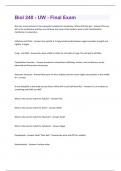Exam (elaborations)
Biol 240 - UW - Final Exam questions and answers graded A+
- Course
- Institution
Not very many proteins in the eukaryotic cytoplasmic membrane. Where did they go? - Answer-They are still in the membrane and they are still busy, but most of the proteins went to the mitochondrial membrane in eukaryotes. Cellulose and Chitin - Answer-Use specific b-1,4-glycosidic bonds between ...
[Show more]



